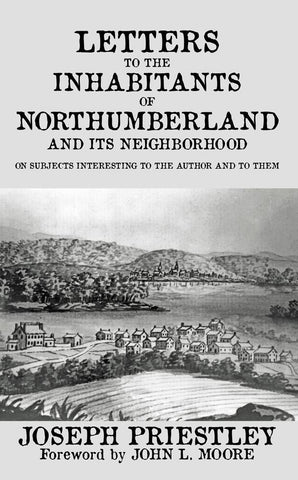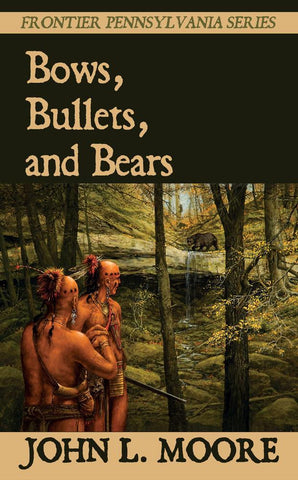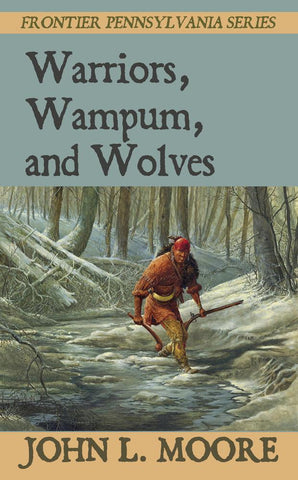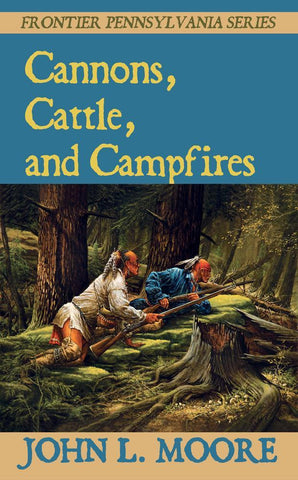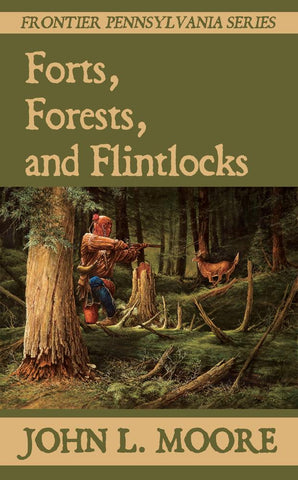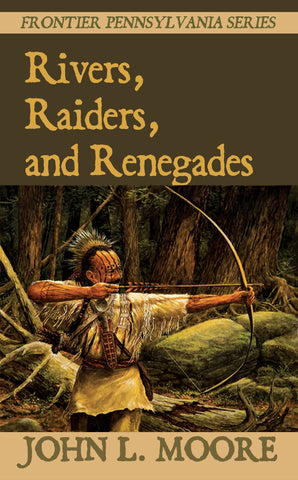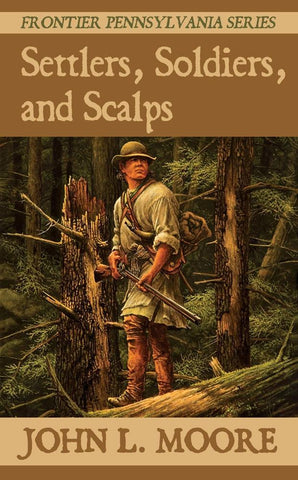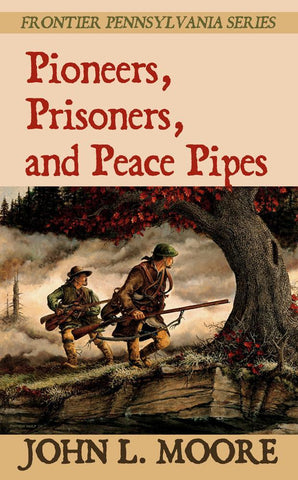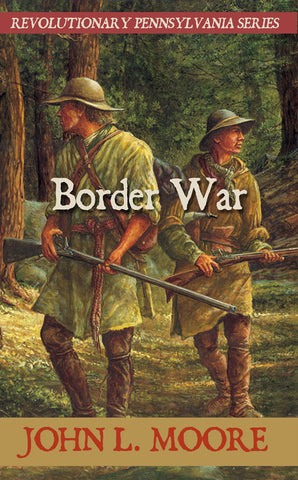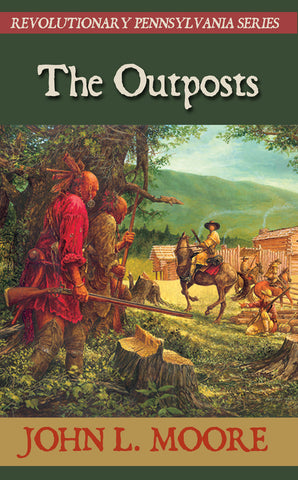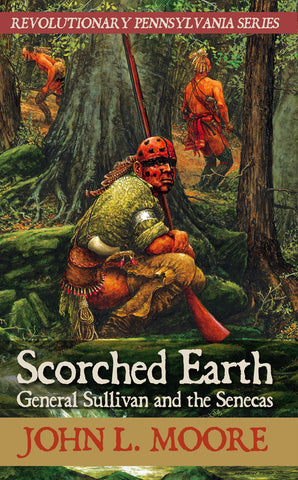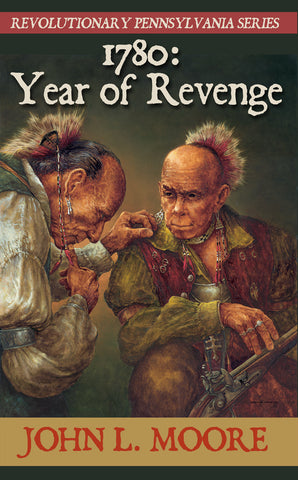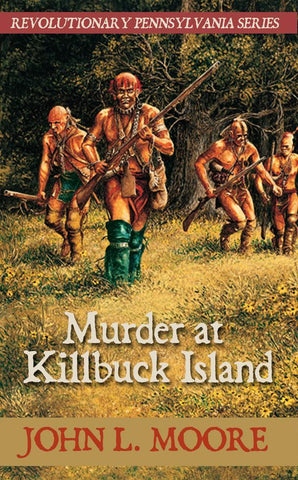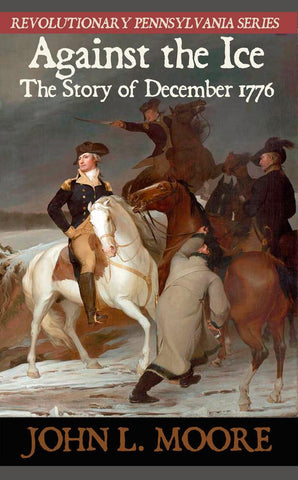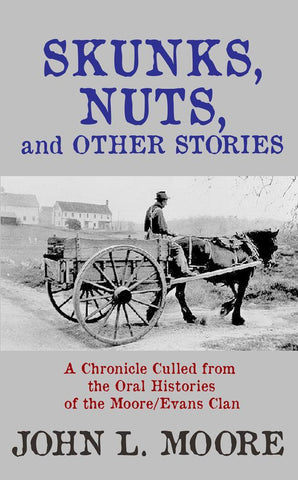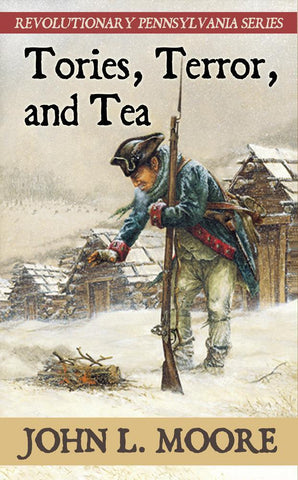by John L Moore
Frontier Pennsylvania Series
As he traveled across the Pennsylvania Frontier in 1743, naturalist John Bartram didn’t know what to expect when he accepted an invitation to spend the night in the cabin of a white man who traded goods for furs with the Indians. The cabin was near the native town of Shamokin (present-day Sunbury) along the Susquehanna River. “About midnight, the Indians came and called up him and his squaw,” Bartram wrote later. “She sold the Indians rum. ... Being quickly intoxicated, men and women began first to sing and then dance round the fire.”
Bartram is one of many early Pennsylvanians that people this colorful non-fiction work. Others include Conrad Weiser, the Pennsylvania Colony’s Indian agent; William Penn, the colony’s visionary founder; Madame Montour, an interpreter who was the daughter of an Algonquin mother and French father; and Major General Edward Braddock, who led British troops against the French army in the Ohio River Valley.
Author John L. Moore raises and answers many questions about who the frontiersmen and natives were and what they did. What was William Penn’s colony like in its early days? How did the Lenni Lenape Indians living in Penn’s colony obtain their food? What did they eat? How did they get along with Penn, and how did Penn get along with them? Why did Penn’s sons recruit athletic young men to walk the boundary of land the Lenape weren’t especially interested in selling?
These true stories are set mainly in the valleys of the Delaware, Juniata, Lehigh, Ohio and Susquehanna rivers. They chronicle many aspects of a nearly forgotten past.
The Iroquois, for example, claimed the land along the Susquehanna and its tributaries by right of conquest of the Susquehannocks. They regarded the Juniata River Valley as prime hunting land. During the late 1740s they became distressed to see white settlers cross the Susquehanna and begin to build homesteads in territory they hadn’t sold and had intended to reserve for themselves.
In May 1750 a posse of magistrates and lawmen sent by Gov. James Hamilton rode up the Juniata and began evicting the squatters. Iroquois representatives accompanied them and forced the Pennsylvanians to set fire to the cabins of the homesteaders.
Eventually, the Indians left the Susquehanna Valley. White settlers who subsequently ventured into the upper Susquehanna during the 1780s came into a region that was still remote and desolate. The forests and fields of Pennsylvania still teemed with game, and one of these whites, Philip Tome, became a professional hunter. He let his dogs chase deer, used torchlight to hunt at night, and kept written records. One year, “every time I saw a bear, I marked it down, and in a month I counted 43,” Tome said.
Page Count: 110
Trim Size: 5 x 8
Publish Date: November 29, 2014
Imprint: Sunbury Press
Genre: History
You might also like ...
-
Letters to the Inhabitants of Northumberland$11.95by Joseph Priestley, Edited by John L. Moore, F...by Joseph Priestley, Edited by John L. Moore, Foreword by John L. Moore A world-famous Englishman, Dr. Joseph Priestley addressed the 12 letters in this little book to “the Inhabitants of Northumbe...
-
Bows, Bullets, and Bears$11.95Frontier Pennsylvania Series Jack Armstrong die...Frontier Pennsylvania Series Jack Armstrong died violently along the Juniata River in early 1744. Armstrong was a rough-and-tumble frontier trader whose sharp business practices antagonized one Ind...
-
Warriors, Wampum, and Wolves$11.95by John L Moore Frontier Pennsylvania Series In...by John L Moore Frontier Pennsylvania Series In April 1753, frontier missionary David Zeisberger prepared for a month-long voyage up the Susquehanna River’s North Branch by walking along the river ...
-
Cannons, Cattle, and Campfires$11.95by John L Moore Frontier Pennsylvania Series Au...by John L Moore Frontier Pennsylvania Series Author John L. Moore serves up a miscellany of fascinating depictions of obscure but authentic people and situations in this non-fiction book about the ...
-
Forts, Forests, and Flintlocks$11.95Frontier Pennsylvania Series As the officer in ...Frontier Pennsylvania Series As the officer in charge at Hyndshaw’s Fort in the Pocono Mountains, Captain John Van Etten knew that few Indian war parties raided the settlements during the snowy win...
-
Rivers, Raiders, and Renegades$11.95by John L Moore Frontier Pennsylvania Series As...by John L Moore Frontier Pennsylvania Series As the Delaware Indians moved west through Pennsylvania during the 1700s, they carried with them tribal memories of the day they first met people from E...
-
Settlers, Soldiers, and Scalps$11.95by John L Moore Frontier Pennsylvania Series Ba...by John L Moore Frontier Pennsylvania Series Barbara Leininger and Marie LeRoy were teenage girls living along Penns Creek in central Pennsylvania in 1755 when an Indian war party captured them and...
-
Pioneers, Prisoners, and Peace Pipes$11.95by John L Moore Frontier Pennsylvania Series Hi...by John L Moore Frontier Pennsylvania Series Histories can be two-dimensional; these contain information strung along timelines. Other histories are three-dimensional, fleshing the basics out with ...
-
Border War$11.95by John L Moore Revolutionary Pennsylvania Seri...by John L Moore Revolutionary Pennsylvania Series Months after the October 1781 surrender of the British army at Yorktown, pro-British Indians continued to raid American frontier settlements along ...
-
The Outposts$11.95by John L Moore Revolutionary Pennsylvania Seri...by John L Moore Revolutionary Pennsylvania Series When the American Revolution began in 1775, neither the British nor the Americans wanted to involve the native tribes. “This is a family quarrel be...
-
Scorched Earth: General Sullivan and the Senecas$11.95by John L Moore Revolutionary Pennsylvania Seri...by John L Moore Revolutionary Pennsylvania Series Throughout 1778, Iroquois war parties repeatedly raided the frontiers of Pennsylvania, New York, and New Jersey. In 1779, General George Washington...
-
1780: Year of Revenge$11.95by John L Moore Revolutionary Pennsylvania Seri...by John L Moore Revolutionary Pennsylvania Series 1779 was the fifth year of the American Revolution, and many Iroquois Indians living in western New York sided with the British. Their war parties ...
-
Murder at Killbuck Island$11.95by John L Moore Revolutionary Pennsylvania Ser...by John L Moore Revolutionary Pennsylvania Series One Sunday in 1782, white vigilantes suddenly appeared at a camp of Delaware Indians on an island in the Allegheny River near Fort Pitt in western...
-
Against the Ice: The story of December 1776$11.95by John L Moore Revolutionary Pennsylvania Seri...by John L Moore Revolutionary Pennsylvania Series A wintry December 1776 forced General Washington’s army to struggle against the ice, snow, sleet, and wind as well as against Hessian and British s...
-
Skunks, Nuts and Other Stories$11.95by John L Moore A Chronicle Culled from the Ora...by John L Moore A Chronicle Culled from the Oral Histories of the Moore/Evans Clan As a boy delivering newspapers after school, author John L. Moore once found a copy of Playboy magazine on the gra...
-
Tories, Terror, and Tea$11.95by John L Moore Revolutionary Pennsylvania Seri...by John L Moore Revolutionary Pennsylvania Series With the sesquicentennial of the American Revolution on the horizon, Tories, Terror, and Tea delves deeply into contemporary accounts of the times ...
-
Letters to the Inhabitants of Northumberland$11.95by Joseph Priestley, Edited by John L. Moore, F...by Joseph Priestley, Edited by John L. Moore, Foreword by John L. Moore A world-famous Englishman, Dr. Joseph Priestley addressed the 12 letters in this little book to “the Inhabitants of Northumbe...
-
Bows, Bullets, and Bears$11.95Frontier Pennsylvania Series Jack Armstrong die...Frontier Pennsylvania Series Jack Armstrong died violently along the Juniata River in early 1744. Armstrong was a rough-and-tumble frontier trader whose sharp business practices antagonized one Ind...
-
Warriors, Wampum, and Wolves$11.95by John L Moore Frontier Pennsylvania Series In...by John L Moore Frontier Pennsylvania Series In April 1753, frontier missionary David Zeisberger prepared for a month-long voyage up the Susquehanna River’s North Branch by walking along the river ...
-
Cannons, Cattle, and Campfires$11.95by John L Moore Frontier Pennsylvania Series Au...by John L Moore Frontier Pennsylvania Series Author John L. Moore serves up a miscellany of fascinating depictions of obscure but authentic people and situations in this non-fiction book about the ...
-
Forts, Forests, and Flintlocks$11.95Frontier Pennsylvania Series As the officer in ...Frontier Pennsylvania Series As the officer in charge at Hyndshaw’s Fort in the Pocono Mountains, Captain John Van Etten knew that few Indian war parties raided the settlements during the snowy win...
-
Rivers, Raiders, and Renegades$11.95by John L Moore Frontier Pennsylvania Series As...by John L Moore Frontier Pennsylvania Series As the Delaware Indians moved west through Pennsylvania during the 1700s, they carried with them tribal memories of the day they first met people from E...
-
Settlers, Soldiers, and Scalps$11.95by John L Moore Frontier Pennsylvania Series Ba...by John L Moore Frontier Pennsylvania Series Barbara Leininger and Marie LeRoy were teenage girls living along Penns Creek in central Pennsylvania in 1755 when an Indian war party captured them and...
-
Pioneers, Prisoners, and Peace Pipes$11.95by John L Moore Frontier Pennsylvania Series Hi...by John L Moore Frontier Pennsylvania Series Histories can be two-dimensional; these contain information strung along timelines. Other histories are three-dimensional, fleshing the basics out with ...
-
Border War$11.95by John L Moore Revolutionary Pennsylvania Seri...by John L Moore Revolutionary Pennsylvania Series Months after the October 1781 surrender of the British army at Yorktown, pro-British Indians continued to raid American frontier settlements along ...
-
The Outposts$11.95by John L Moore Revolutionary Pennsylvania Seri...by John L Moore Revolutionary Pennsylvania Series When the American Revolution began in 1775, neither the British nor the Americans wanted to involve the native tribes. “This is a family quarrel be...
-
Scorched Earth: General Sullivan and the Senecas$11.95by John L Moore Revolutionary Pennsylvania Seri...by John L Moore Revolutionary Pennsylvania Series Throughout 1778, Iroquois war parties repeatedly raided the frontiers of Pennsylvania, New York, and New Jersey. In 1779, General George Washington...
-
1780: Year of Revenge$11.95by John L Moore Revolutionary Pennsylvania Seri...by John L Moore Revolutionary Pennsylvania Series 1779 was the fifth year of the American Revolution, and many Iroquois Indians living in western New York sided with the British. Their war parties ...
-
Murder at Killbuck Island$11.95by John L Moore Revolutionary Pennsylvania Ser...by John L Moore Revolutionary Pennsylvania Series One Sunday in 1782, white vigilantes suddenly appeared at a camp of Delaware Indians on an island in the Allegheny River near Fort Pitt in western...
-
Against the Ice: The story of December 1776$11.95by John L Moore Revolutionary Pennsylvania Seri...by John L Moore Revolutionary Pennsylvania Series A wintry December 1776 forced General Washington’s army to struggle against the ice, snow, sleet, and wind as well as against Hessian and British s...
-
Skunks, Nuts and Other Stories$11.95by John L Moore A Chronicle Culled from the Ora...by John L Moore A Chronicle Culled from the Oral Histories of the Moore/Evans Clan As a boy delivering newspapers after school, author John L. Moore once found a copy of Playboy magazine on the gra...
-
Tories, Terror, and Tea$11.95by John L Moore Revolutionary Pennsylvania Seri...by John L Moore Revolutionary Pennsylvania Series With the sesquicentennial of the American Revolution on the horizon, Tories, Terror, and Tea delves deeply into contemporary accounts of the times ...
Recently Viewed Products
Well written



